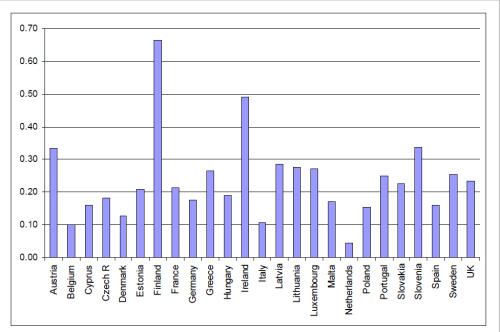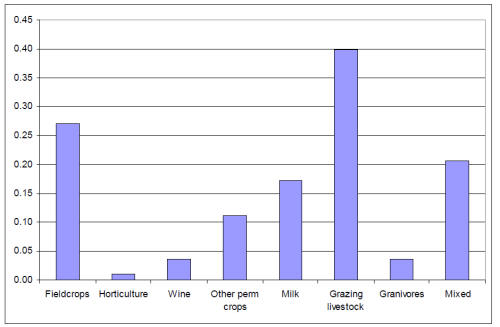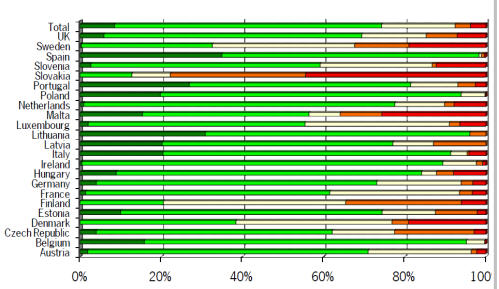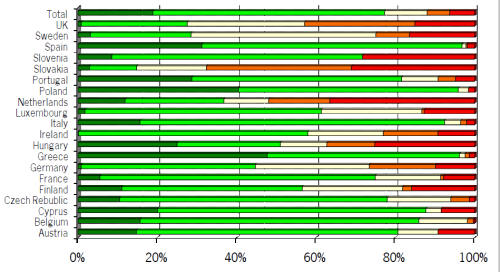



Farm Viability In The European Union
This study by the University of Wageninen in the Netherlands, describes the importance of farm subsidies in the EU and analyses the impact of changes in levels of farm subsidies on the viability of farms and regional difference in farm viability. Summarised by Charlotte Johnston, TheCattleSite junior editor.What determines farm viability?
Farm viability is determined by the level of farm incomes but also by the fluctuation of incomes and the level of leverage (use of loans).
Incomes in agriculture show strong fluctuations over time due to fluctuations in prices and yields. The level of income is also influenced by the amount of farm subsidies.
Dependency on subsidies
The dependency of farm on governmental subsidies differs strongly. In general, farm size has increased to achieve economies of scale; production has become more specialised with a continuous reduction in labour input and an increase in capital.
Local differences such as land quality, weather conditions, water supply, costs of land and labour, distance to markets and processors as well as economic viability of rural areas and unemployment all vary greatly, affecting reliance on subsidies.
In addition to these factors national fiscal and social security policies influence changes in farm structure; in Central and Eastern Europe the transition to the western economic system and to EU membership played a major role.
Changes in policies on farm subsidies could affect these areas to different extents.
Differences in EU countries
Figure 1 provides an overview of the importance of agricultural subsidies in the total output value of agriculture on farms in the European Farm Accountancy Data Network (FADN).
In comparing countries huge differences can be observed.
These differences can be explained by taking into account the type of agricultural subsidies and the agricultural production in a country.
Figure 2 shows the share of agricultural subsidies in total output for the various types of farming.


Impact of changes on farm viability
In this study an analysis was made as to how robust a farm must be to survive a policy change consisting of a partial or a complete abolishment of farm subsidies.
The analysis categorise farms as one of the following post abolishment of subsidies:
Category 1/ excellent prospects: Farms with positive incomes, high opportunity costs and good prospects. They are in the position to save money for investments in the farm.
Category 2/ good prospects: Farms with positive incomes, but they are unable to provide a full compensation of costs of labour and capital of the farmer and his family.
Category 3/ poor prospects: Farms with negative incomes, they will have to delay depreciation causing long term problems. They have difficulty modernising and adjusting the farm.
Category 4/ bad prospects: Farms with negative incomes, no adequate opportunities to postpone redemption. They have to improve their income to stay viable in the long run.
Category 5/ no prospects: These farms had a negative income prior to the abolishment of payments. They are now in an even weaker situation. Financial distress of financial necessity will lead them to bankruptcy - however this will depend on other factors such as farm wealth, off-farm wealth, off- farm income etc.
The study looks at the abolishment of all subsidies, including decoupled and production related payments, as well as only the abolishment of decoupled payments.
Dairy farms
On dairy farms, the share of all subsidies in total output is approximately 18 per cent.
The abolishment of all subsidies has a more severe impact on the income position of dairy farms than the abolishment of subsidies.
About 10 per cent of farms with a positive income when decoupled payments are abolished, swing to a negative income when all subsidies are cut.
Denmark, France, Germany, Luxembourg, Sweden and the UK represent many farms in this category.
The severe fall in dairy and milk prices in 2008/09 has severely weakened the financial position of many dairy farmers.
Sweden, Malta, Slovakia, Finland and to a lesser extent, Denmark and the Czech Republic, have the highest proportion of farms which were providing a negative income prior to the abolishment of subsidies.

>Slovakia would be the worst hit if all subsidies were removed, with only less than 15 per cent of farms left making a positive income.
Denmark, Finland, Malta, Slovakia, France, Sweden, Luxembourg and Latvia are all member countries with the lowest share of farms with good prospects after the abolishment of subsidies.
Spain (with 35 per cent) and Lithuania (with 30 per cent) would be the member countries with the highest proportion of farms with excellent opportunities. They were followed closely by Portugal, Latvia, Poland and Italy.
The country with the largest social divided between dairy units (high proportion of farms with excellent opportunities and high proportion of farms with no prospects) was Malta.
In total, about seventy five per cent of all dairy farms in the EU would be viable (making a positive income) if subsidies were to be abolished. Of the remaining, only 10 per cent would be critical, with no future prospects or bad prospects.
Figure 4 shows that after the abolishment of decoupled payments slightly less than 20 per cent of the grazing livestock farms are in category 1 - excellent prospects, and about nine per cent in the last category - with no prospects.

A large part, nearly 60 per cent, of the grazing livestock farms in the EU fall into category 2 - good prospects. However the study highlights that the differences between the countries are rather large.
Should all subsidies be abolished (Figure 5) - the effect would be much worse. Just over 10 per cent of farms would fall into category 1, whilst nearly 30 per cent of farms would fall into category 5.

Only 40 per cent of farms would have good future prospects. Again there is a large difference between countries.
The majority of Slovakian and Finnish farms would fall under category 4 - with poor prospects. They are closely followed by the UK and the Czech Republic.
In contrast Spain, Poland, Italy and Greece all have a high proportion of farms with good prospects.
This huge difference between the effect of abolishing decoupled payment and all subsidies, is due to the fact that suckler cow premiums, slaughter premiums and sheep and goat premiums have not been fully decoupled in many countries.
The share of farms with a shift from positive incomes to negative incomes due to the policy change are extremely high in the Czech Republic, Finland, Slovakia, the UK and Sweden.
Conclusion
The study tries to quantify the effects of changes in policies on farm subsidies on the viability of farms.
The study showed that the level of subsidies (as a percentage of farm output) is the highest in the grazing livestock sector (without dairy farms), followed by field crop (or arable) farms, mixed farms and dairy farms.
Subsidies on other types of farms, including horticulture, permanent crops and wine as well as intensive livestock are much lower.
The reason for these differences in the importance of subsidies is first of all that the last mentioned farm (nearly) do not produce products related to the system of CAP - premiums. These premiums, e.g. for cereals, sugar beet, cattle and milk are for a large part decoupled after the CAP reform in 2003.
Countries with the highest percentage of farms in categories 3 and 4 are heavily affected by the abolishment of subsidies. In these countries many farms that have positive incomes before the policy change have negative incomes after the abolishment of subsidies.
The abolishment of all (farm) subsidies would have a severe impact on the viability of farms.


